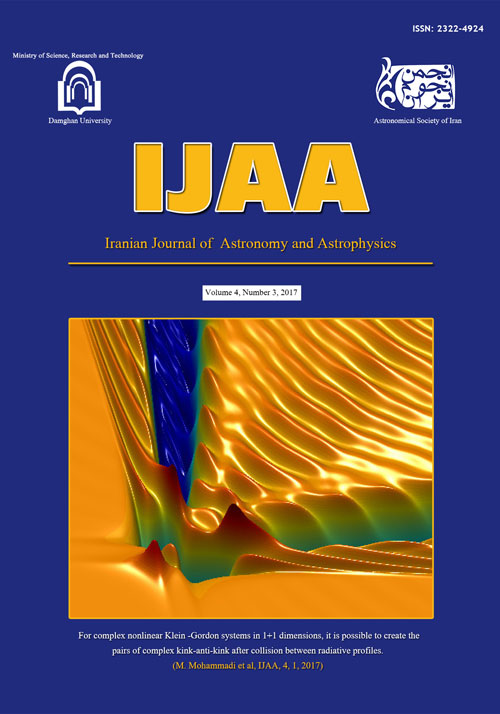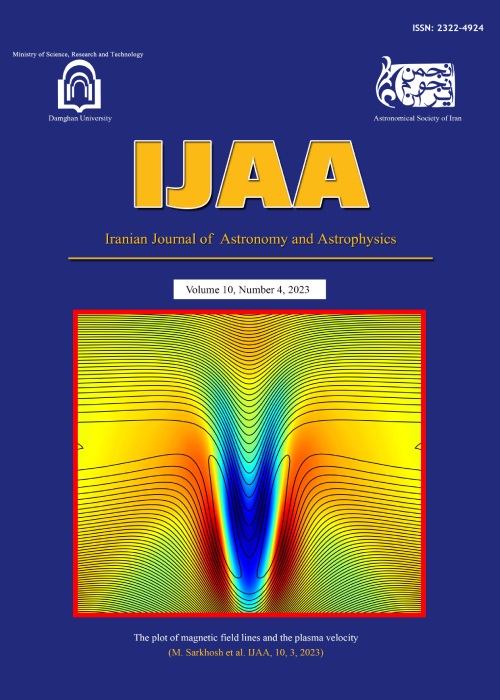فهرست مطالب

Iranian Journal of Astronomy and Astrophysic
Volume:5 Issue: 1, Winter 2018
- تاریخ انتشار: 1396/12/10
- تعداد عناوین: 6
-
-
Pages 1-7
Over the past years, two-dimensional materials such as graphene, phosphorene, silicene, and boron-nitride have attracted the attention of many researchers. After the successful synthesis of graphene, due to its many new applications, researches began to produce nanosheets from other elements, and among these elements, boron was one of the options. In the periodic table of elements, boron is ahead of carbon and after beryllium, which exhibits metallic and non-metallic properties. The two-dimensional boron sheets called borophene are one of the allotropes of this element that reaches their stable and single-layer structure by forming triangular lattice and the carbon like SP2 hybridization. Since boron is carbon’s neighbour, so it is expected that two-dimensional boron sheets would have properties close to graphene. Here, we investigate the wettability of the borophene mono-layer surface by calculating contact angle of the water and the surface of the sheet by using the molecular dynamics simulation method. According to the measurements obtained from this simulation, the contact angle is approximately 131 degrees, indicating that such a structure is hydrophobic. Also, the effect of diameter of nanodroplet on the surface contact angle has been studied.
Keywords: wettability, borophene, contact angle, molecular dynamics -
Pages 9-20
Extracting the temperature of coronal loops is effective in the analysis of solar active region's loops and helps in better understanding of coronal events. To this end, various methods have already been developed like the method developed by Aschwanden et al. 2015 [10] which is based on Gaussian fit for Differential Emission Measure (DEM). Here, we use the intensity ratios of the images in three different wavelengths and the temperature response functions of AIA to extract the temperature of the loop. In this paper, we use EUV images of the solar active region 11092 taken by AIA instrument of the SDO satellite at 171, 193, and 211 A0 wavelengths, at 1th of August, 2010. We select a loop in a subregion of 11092 and extract its temperature by the help of intensity profiles in different wavelengths and thermal response functions of different filters. In this subregion cooling of the loop happens and in the selected loop, highest relative intensity of the wavelengths of 171 A0 to 193 A0 was obtained to be 0:76 and this number was estimated to correspond to the temperature of 1.3 million degree of Kelvin, which is the maximum temperature point of this loop's internal area. The highest values of the intensity ratios at the wavelengths of 211A0 to 193A0, and 211A0 to 171A0 are 0:22 and 0:25, which correspond to temperature values around 10M and 1.4M Kelvin in sequence, related to the temperature of hotter and more superficial points of the loop respectively. These values are very sensitive to time and differ in time series of this event of the loop intensity variation.
Keywords: Solar Corona, Solar Active Region, SDO Satellite, Corona Image Processing -
Pages 21-32
Recognition of the appropriate locations for ground-based observations of the Sun with high angular resolution depends on the factors such as seeing, meteorological and astronomical parameters. Seeing is one of the most effective parameters that could limit the quality of the observations. Therefore, to have an accurate observation, one needs to have an accurate estimation of this parameter. Using Solar Differential Image Motion Monitor (S-DIMM) method, the day-time seeing parameter is estimated for the first time at Optical Observatory of University of Zanjan, Iran. Because of hard observational conditions, the data collected at a height of 8 meters above the ground between 3rd of July to 18th of October 2018, using an 8 Inch MEAD telescope covered with a two-hole Hartman mask and a 99.99999 % solar glass filter. The results of Fried Parameter at the Observatory of University of Zanjan show a median value of 5.3 cm, with the first, and third quartiles being equal to 8.3 to 3.6 cm, respectively. The best seeing results are obtained between 9:00 to 9:30 a.m., Iran local time. Above the 6% of the measured Fried parameters are obtained to be larger than 10 cm, which seems to be better than the seeing condition at TUBITAK National Observatory, Turkey. The obtained median value of the Fried parameter during the observation period of this study is comparable with the median Fried parameters measured at good solar observatory sites, such as, Big Bear, Haleakala, La Palma, Panguitch Lake, Sacramento Peak, and San Pedro Martir, during July-September. Continuous Day-time seeing observations are needed to make a better comprehensive comparison.
Keywords: Atmospheric Effects, Site testing, Turbulence, Seeing -
Pages 33-39
Recent studies show that two completely distinct fields as quantum information and string theory realization can be related and share some of the same properties. So, the knowledge on quantum information of some special quantum systems provides new insights on the sting theory. We analytically study geometric discord and measurement induced nonlocality for a Horodeckis' 33 bound entangled state to find quantum correlation. We find that there is a simultaneous sudden change point in the geometric discord and the measurement-induced nonlocality in the region of the bound entangled states, which is considerable. Moreover, we investigate the lower bound of geometric discord and the upper bound of measurement-induced nonlocality for this system. This study leads to some new and interesting novel results as well.
Keywords: geometric quantum discord, measurement induced nonlocality, quantumcorrelations, qutrit-qutrit system -
Pages 41-49
The slip distribution of a moderate earthquake in Iran, the 27th of August, 2010 Mw 5 : 8 Kuh-Zar earthquake, was estimated from regional broadband seismic data using constrained non-negative least squares linear slip inversion method. A great many inversions were carried to determine the optimal parameters used in the process such as rupture velocity and rise time. A rupture velocity of 2.55 km/s and rise time of 1.8 s were utilized for the event. Results show a rupture with peak slip of 15.0 cm and total seismic moment release of 2 × 1025 dyne-cm. The effect of the stations with different epicentral distances was also analyzed using a sensitivity test. Due to the non-uniqueness of the inversion problem, a set of solutions is presented for the Kuh-Zar earthquake. To the best of our knowledge, this is the first time to consider constrained non-negative least square linear finite-fault inversion procedure to the Kuh-Zar earthquake.
Keywords: the 2010 Juh-Zar earthquake, seismic data, slip inversion -
Pages 51-62
In this paper, we investigate the inuence of the magnetic field and the temperature gradients on the stability of a spherical cloud. Observational data confirm a power-law relation between the magnetic field and the gas density. Here, we study the stability of a magnetized cloud with a toroidal magnetic field and the polytropic equation of state. We find that density and mass profiles of the modified clouds are departed from the non-magnetized isothermal case. As the result, the critical mass, radius and density contrast at the onset of the gravitational instability differ from the critical Bonnor-Ebert mass and its critical radius and density contrast. Thus, both the magnetic field and the temperature gradients play important roles in the structure of the cloud. Furthermore, the cloud critical mass is increased for the higher values of the polytropic exponent, irrespective of the values of the magnetic to thermal pressure ratios or the field gradients. Different values of the magnetic field gradient and strength change the values of the critical density contrast and radius of the cloud; however, both of them fade their importance in the values of the critical mass.
Keywords: ISM: stars formation


